The Seamstress of Monkey Bay
I started at the “Cash and Carry” grocery store, where I quenched my thirst with three small bags of strawberry yogurt. The store was out of water, which wasn’t surprising. Not only was the temperature climbing up to around 100F with oppressively high humidity, but there was also a crippling fuel shortage in the country, which made it difficult for some companies to deliver to the more rural areas. Yet somehow, the vans and minibuses were able to find fuel, and they sat outside of the grocery store honking their horns like a seasoned New York cabbie and yelling their destinations to all who walked by.
I crossed the road and ducked under the low-hanging branches of a tree that partially conceals one of the entrances to the market. I followed the man from the grocery store who was going to introduce me to the best seamstress in town. We navigated through the narrow alleys, over broken mud bricks, and passed stalls that sell everything from freshly-made french fries to collared dress shirts and Chinese-made flashlights. Some men sat in the middle of the dusty paths with buckets of small fish, which gave off a very powerful stench because they had been sitting in the hot sun all day. I batted away the flies as I leaned against a wall to let someone else pass through the narrow walking corridor.
I tried to pay as much attention to all the turns we made through the maze-like market because I knew I would eventually need to find my way back out. After a few minutes of walking (though it seemed like much longer due to the sensory overload), my impromptu guide stuck his head through the window of a small mud-brick building and called out a greeting to the smiling lady sitting behind a black sewing machine. Then he turned to me and beckoned me to enter.
The shop is small, only about a meter and a half by four meters. The store front, made up of one of the longer sides of the room, has a door (which is always open during business hours to let in light and air) and three large glass-less windows. A small bench and two wooden tables are pushed up against the windows so the seamstresses can use the natural light to complete their work. This is necessary because there is no electricity in the market. The long back wall of the room has shallow shelves from the floor to the ceiling. This is where scrap material, cut cloth for clients, and completed items are stacked and hung. Every once in a while, a stack would tumble onto the dirt floor. Along each short wall of the room, there is a manual sewing machine. Although the two machines are different makes, they are both foot-powered, basic Chinese-made black metal models. They both have detailed floral paintings and intricately etched steel plates which give them an old-world feel, even though their lack of chipped paint makes me think they are relatively new.
This is where Mariam Kawinga works as a seamstress.
When I arrived, there were two other women sitting on the bench chatting with Mariam as she sewed a green school uniform. She stood up to greet me and inspect the bundles of material I had.
“It’s Malawian material. The colors are beautiful, but I don’t like Malawian material.” When I asked her why, all she would say was, “Tanzanian is better.”
She rubbed the material between her fingers as she said that. I haven’t noticed a difference between their feel, but I haven’t felt them both at the same time to make a proper comparison. The main difference I have noticed between Malawian and Tanzanian material is the design style. Tanzanian material better matches the Western stereotype of what African fabric should look like, employing bold designs, broad lines, exaggerated features, and bright colors (mostly black, brown, gold, green, and blue). Malawian material uses designs and patterns that borrow from the modern way of life, like my music themed material or the heart themed one mentioned in the DWS Mapeto entry. I’ve also seen patterns made of diamond rings and high heels. I don’t see this as making one country’s material better than the other, just more suitable for specific markets.
I told Mariam that I would like a few skirts made from the material I gave her. She pointed behind one of the sewing machines to a large poster that showed a few dozen dress styles being modeled by a small child. I already had an idea of what I wanted the skirts to look like, so I was pleased when I was easily able to find two similar styles on the poster. One was advertised as a very popular style in Nigeria, but the other did not list a country of origin. Mariam nodded when I pointed out the two styles, then immediately went to work measuring my waist, hips, legs, and other measurements in between. I asked her to keep one of the skirts long, but to modify the other so it would reach my knees instead of my ankles. She laughed and shook her head, but obliged.
She went back to chatting with the other people in the shop (and the ones in the alley who were intrigued by the appearance of a mzungu in the local market) as she unfolded and folded my fabric, smoothing out the wrinkles before making another fold. Some of the folds reminded me of origami. Each fold was made with precise lengths determined by the bright yellow tape measure that hung around Mariam neck. She marked out each fold and each measurement with white chalk. When she began cutting along all of the dusty marks, she used her tape measure to create perfect circular cuts by holding one end of the tape measure in one spot and spinning the rest around that point as she cut.
Her hands moved so deftly, measuring and cutting, and only glancing at the book where she wrote down my measurements once. She wore a black scarf wrapped around her head despite the heat. I had sweat dripping down my forehead within only a few minutes of entering the shop. The windows and the door were all opened, hoping to tempt a breeze, but there was not the slightest stirring of the air to help cool the room.
Mariam has been working as a seamstress for three and a half years. Her mother was also a seamstress. She did not learn how to be a seamstress from her mother, but from a trade school so she would have better qualifications. She has only one child, a daughter, but she says her daughter does not want to become a seamstress; she wants to become a lawyer. One of the reasons why Mariam chose to work as a seamstress was because she could earn more money doing that than many other jobs, and she needs the money to pay for her daughter’s school fees. She also uses the money to support her aging parents. She saves a little each month so she can buy a house.
Mariam is bright and slightly shy. She laughed often when she chatted with her friends and customers, but every time her gaze returned to her work, her expression became one of intense concentration. While working at the sewing machine, she took off her sandals to protect them and keep them looking new. She was fascinated by my camera and insisted that I have my photograph taken with her. She laughed freely as she moved my head, shoulders, and arms into various poses for the pictures.
When she finished cutting the material for my skirts, she returned to the sewing machine to finish two shirts before her customers came to pick them up. I stayed in the shop, watching, sweating, photographing, chatting, laughing, and entertaining with my broken Chichewa, until shortly before sunset. The temperature had only dropped a few degrees, but the absence of the direct sun on my skin made the bike ride home much more tolerable.
I returned to the shop a few days later to pick up four beautifully made skirts. How many other people can say that they own a personalized skirt, let alone that they followed the production of those skirts from the raw cotton, through the spinning, weaving, printing, packaging, measuring, cutting, and sewing all the way to the finished product? That’s one of the best parts about living in a place like this where everything is made locally.
David Whitehead & Sons Mapeto: The Factory
Whether you’re wandering the streets or just driving through, one of the typical Malawian elements that you are most likely to notice are the brightly colored skirts and head wraps worn by the local women. They have bold designs and vibrant colors, and they are often worn in elaborate styles. Some of the women wear the material as a chitenji, which is like a simple sarong or wrap-around skirt. These are layered, usually three or four on top of one another, but more are worn during the cooler months or if the woman will need to re-appropriate one of the chitenji as a sling to hold a baby. Seamstress shops are easily found in every town for the women who choose to cut their material into fashionable skirts, dresses, or full ensembles.
Although more than half of the material found in most of the markets is imported from Tanzania, Malawi also makes its own fabric. The main producer is David Whitehead & Sons Mapeto, or DWS Mapeto, which is located in Blantyre, the commercial center of the country. I was lucky enough to be given a personal tour of the factory, where I spoke with workers, managers, printers, and designers.
The tour of the factory followed the journey the cotton takes as it progresses through the plant. Upon entering the building, I saw a man surrounded by scales and giant bundles of raw cotton. He was picking through the cotton to separate it and remove any major impurities. In the following rooms, the cotton is pulled apart even further to remove more impurities, and then it is spun into a thick, loose yarn. In the next few rooms, the yarn is spun again and again until it becomes thin, tough thread.
It is difficult to talk or breathe in these rooms because the spinning pulls off pieces of the cotton and throws it into the air. The rooms look dusty, but it is only the cotton floating around. When breathing or talking, pieces of this cotton (which can sometimes be quite large) get into the nose and mouth, which is rather uncomfortable. The men wear masks, but I was in these rooms for such a short time that I did not wear one.
In some of these rooms, only a few of the machines were operating. That wasn’t because the machines were broken but because there wasn’t enough material that day to make it necessary to use every machine.
Once the yarn is worked into a thread of a proper thickness and placed on spindles, it is brought to the weaving department. Here, hundreds of threads are lined up alongside one another until they reach the desired width of the final piece of material, which is usually around 4 to 9 feet wide. The threads, each 50,000 meters long, are then wound around a giant spindle called a beam.
From here, the beams are placed into a machine that will coat the thread in starch to strengthen the thread in preparation for the weaving. Two different kinds of starch are used, corn starch, which is bought from China, and cassava starch, which is made in Malawi. Each starch has slightly different properties, but it doesn’t affect the weaving process.
The weaving is completed by three different types of machines; air-jet, electronic, and projectile. Some machines are Swiss while others are American. Nearly all of the machines are relatively new, but there are still two rows of machines that have survived since the factory was first opened, and they still work wonderfully. Regardless of which type of machine is used, all the thread is woven into identical swaths of white cloth.
Just like in the spinning rooms, the machines move so quickly over the thread that pieces of cotton are thrust into the air. The room looked hazy, which makes it difficult to see across the enormous room. Only some of the workers here wore face masks, but those who went without didn’t seem bothered by the cotton tickling their noses and throats. Most didn’t wear ear protection either, despite the noise, which is so loud that people standing next to each other can scream to communicate, but neither will understand the other unless they can lip-read.
While the men are diligently working in the weaving department, other groups are working equally as hard in the design and engraving departments. The design team works at a separate location, while the engraving team (who carves the designs onto the plates that are used during printing) works in a darkroom next to the printing room.
The designers create designs in three different ways: through working from foreign samples, through customer requests, and through their own ideas.
Samples are brought in from countries from around the world, but the most popular ones come from China and Ireland. Some of these samples are copied exactly, but others are simply borrowed from and altered to fit the style of the Malawian market.
Customers also bring in their own requests. Sometimes they bring in samples of their own and ask for replicas, but more often, they bring photos of people or logos from their company or organization and have those printed on the material. Most of these types of requests come from religious or political groups that use the material as a form of advertising, just like Western companies do when they print their own name on their products. Besides portraits of leaders and logos, some of the requested designs are used as educational material, describing in words and pictures about things like the history of Malawi or the importance of breast feeding.
The last type of design is created from scratch by the designers. The design used by the engravers to give us a demonstration was this type of design.
For this particular design, the designer began with a heart shape, which he said was often requested by the customers who want to show off their happiness and their love. Since floral designs are very popular, the hearts were arranged into a flower shape, which might also represent blooming love. Most designs come in a few different color schemes, but the designers decide this as well. They also divide the design’s colors into the layers of dye and the order in which those layers will be printed onto the material.
The engraving department takes over from here. Even though the end product is a piece of material, the process that the engraving team follows is very similar to how photographs are made, developed, and printed. They take the color layers and create a plate for each one, much in the same way a newspaper or magazine would for printing photographs. Bright, hot lights are used to “burn” each layer of the design onto a photographic-emulsion-coated metal plate, which similar to how a photograph is imprinted onto a piece of film with light. Because of this method, the room is kept very dark, like a photographic darkroom.
After the plates have had their designs “fixed,” or made permanent (again, like film is “fixed” during developing), they are given to the printing department. The printing department will use each plate multiple times until the moving material eventually wears down the grooves on the plate. The plates are then melted down to be recycled.
Before printing, the material goes through a few more steps before it is ready to receive the dye. First, it is submitted to a rotation of bleaches to ensure the material is evenly whitened. Then it is washed and tested for width, strength, and thickness before it is moved to the printing rooms.
The printing area is dominated by the bitter chemical smell of the dye. The sound of the printing machines is also much louder than expected, although it is much quieter than the weaving rooms. The material is fed into the printing machine where is passes under a series of the round plates. Each plate is covered in a different color ink, and because of the composition of the plates, the ink only sticks to the etched design. This allows the plates to be rolled continuously, creating seamless designs and speedily, efficiently produced prints. When you stand on the walkway next to the rolling plates, you can see in between the rollers and watch the material evolve as each additional layer of dye is applied.

A man monitoring the printing process. Each round plate has a different color, which are printing on top of one another to create a colorful design. DWS Mapeto, Blantyre, Malawi.
The head of the department showed me his supplies of dye. He is proud of his job and even more proud of his skills. Because he has spent so many years working at the company, he says he can make any color that a customer can bring to him. I believe him, especially after having seen the amazing number of base colors he has to start with!

A man quality-checking the material as it comes out of the printing machines. DWS Mapeto, Blantyre, Malawi.
From here, we moved into yet another wing of the plant. Since the cotton production in Malawi can not keep up with the demand for material, the company must import some material from abroad. The cheapest comes from China. Sometimes it is actually cheaper to import than it is to make material at the factory. The one problem with Chinese material is that it is a different width than Malawian material, so it needs different machines to process it. As such, there is an entire wing of the plant dedicated to Chinese material.
Once all of the material is printed, it undergoes a few more steps to make the dye permanent. First, it is moisturized to help the material absorb the color. Next, it is passed through a curing machine, which heats the fabric to 164C, which not only fixes the dye, but it also makes the colors noticeably more vibrant. After washing the material to remove excess dye, more chemicals are applied to make the fabric stiff. Then it’s off to the packing department.
The packing department is the last stage of production at the factory. This is where they perform the final quality checks. They also cut the material into different lengths, the most popular being 1m, 2, 5m, 15m, and 30m, but other sizes do exist. Then they are bundled and packed by a line of men in an assembly line before they are shipped around the country.
I was very impressed with the efficiency of the factory. I have had some trouble finding DWS Mapeto material in some of the markets, but there are stores dotting the cities and countryside. All of these have been wonderfully stocked, and I made sure to buy from them instead of from markets that sell only Tanzanian products. I find the Malawian designs to be more stylish anyway!
Art and Music in the St. Louis Catholic Church
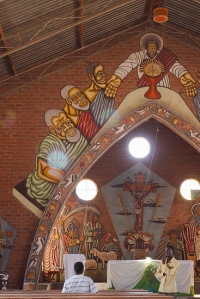
Inside the church, the walls are covered in beautiful art. The choir leaders wait for practice to begin. Monkey Bay, Malawi.
On my last trip to Monkey Bay, I was wandering around with a friend who had not yet visited the town. We visited a few shops and handed out some of the photographs that I was finally able to get printed. Josephy (the bike mechanic) and the group from the mill were very pleased to see their faces smiling back from physical photographs that they could keep (as opposed to the back of a foreigner’s camera). I know they were all surprised that I had followed through on my promise to get them prints. I’m sure they have been promised the same thing hundreds of times before.
Since my friend had never been to Malawi, I showed her the local church since religion is such a large part of the lives of the local people. I chose the church with the art that had so impressed me on my first visit to Monkey Bay, the St. Louis Catholic Church. Even though I had told her that the outside, which is made of simple brick, is a stark contrast to the detailed art on the interior walls, she was still surprised when we walked through the open front doors.
I was also filled with renewed awe at the crisp color and detail that covered the walls. It’s obvious that someone invested a lot of time and effort on the murals and relief sculptures on the columns. The lights hanging from the ceiling, each one unique, are painted with the same bright colors of the walls below.
As a foreigner with a global perspective, I am able to pick out which culture each element of the art and decorations have come from. The colorful paintings are probably the most Malawian parts of the whole building. The style, while still having definite influences from the west, is typical of what I’ve seen in murals inside stores and along the alleys of the markets. They have bold colors and bold outlines, with patterns and variations in color adding contrast and detail to the images.
Along the front of the building, near the altar, there is a selection of statues of Mary and Jesus. These statues have soft features painted in pale pastels, and they are draped in billowing robes that bring to mind the art of the Italian Renaissance. They have obviously been brought in from Europe, which is not surprising, considering it is a Catholic church.
Another statue near the altar, the only one of its kind, was carved out of wood. One might be surprised that I consider this piece of art to be less Malawian, less African, than the paintings. Long ago, there was a time when Africans made wood carvings to fulfill their hunger for art and creation, but now, the carvings only fill their need of making money by selling something, anything, to rich tourists. I do sometimes see a local using a locally carved chair, or in this case, a locally carved statue, but I believe that if tourists stopped buying these carvings, the local people would stop making them because they no longer make them for themselves. All that aside, the statue was still very beautiful and well-made. I could see that the top of the statue came off, presumably to reveal a hollow interior in which something could be kept. I did not want to open the top myself and the priests were not present, so there was no one who could open it for me.
The fusion of pieces of art from so many different cultures reminded me of the Malawian Muslim wedding I photographed a few months ago. The ceremony had followed Islamic customs, but it still had a distinctly African feel. The dancing (which sometimes interrupted the speeches given by the religious leaders) was spontaneous and impulsive, while still maintaining rhythm and order. During the lectures and readings from the Quran, the women in the audience would randomly call out cries of affirmation and praise, which I have never seen in the religious ceremonies I witnessed in Turkey.
Sitting in the pews near the front of the church were a few men who were listening to someone playing a keyboard. The keyboard was hooked up to a humorously large pile of speakers that reminded me of the exuberance you might see in a music video. There were handmade drums stacked near the keyboard, which, as I was later told, are used when the electricity goes out and they can’t use the keyboard.
I asked the man playing the keyboard if I could take his picture, and as I started pulling out all of my gear, a group of people filed into the church and sat in the pews immediately in front of the keyboardist. I popped off a handful of shots before I realized that the people were gathering for choir practice. As I quickly and haphazardly stuffed my gear back into my bags, the keyboardist motioned that I should follow him outside.
We sat on the front steps of the church (where I photographed the children playing so many months ago on my first trip to Monkey Bay) and chatted. The keyboardist’s name is Allan. Despite being around my age, he is still in high school. He has been playing the keyboard for five years and was taught by Daniel, one of the choir leaders, who came over to chat with us and help Allan when his English failed him. Allan told me that he learned to play the keyboard for the church so he could play for god. He said that he will not use his musical talent for secular activities. He is the main musician for the choir, which is 45 members strong. They practice three times every week in preparation for the main service on Sunday. Their songs, which are sung in Chichewa, Yao, Tumbuka, and Lomwe, are usually taken from a song book, but Allan and the choir directors sometimes write their own.
Despite his devotion to his religion, Allan wants to become a soldier, like Daniel, because he says he would be able to help his people. He thinks that being a soldier would be fun, especially if he could work with his best friend, Daniel. Daniel has been a soldier for a long time, so he is confident that he will be able to pull a few strings to get a job for Allan in two years when he finishes his schooling.
The conversation soon turned back to the church, specifically the art inside. The original church is located about 50 ft from where the main church currently stands. The original building was a simple one-room house that had been repurposed. The congregation grew very quickly, forcing people to stand outside and listen through the windows, so, eventually, it was decided that a bigger church was needed.
The current church was completed in 1978. Priest Savala, who came from a different congregation in the Mangochi area, took a full year prior to the opening of the new building to paint murals and add the Stations of the Cross sculptures to the walls. He also painted words of faith on some of the walls and decorated the light fixtures. It’s unknown if any retouching has been done on his work, but from my uneducated inspection, I didn’t see any noticeable signs of retouching. This surprised me because the colors are still so crisp and fresh. There isn’t even any cracking or peeling, both of which are signs of aging I would have assumed to be present on work that is so old and located in a climate that varies between moderately cool and dry to very hot and humid.
In the last few years, the membership of the St. Louis Catholic Church has continued to rise. Once again, the church, which can seat up to 400 people and has standing room for another few hundred, is forced to keep dozens of worshipers outside because there is just no room inside. There is a brother church a few kilometers away, but that one, despite being much larger, is also more than full to capacity.
Allan and Daniel looked very pleased when they began talking about the number of people who attend their church. They said that if you count the Christian denominations separately, the Muslims outnumber them, but with all the denominations added together, Christianity is the most popular religion in the area.
I have not seen any official numbers and it has not been as easy for me to gain access to a mosque, but I would love to hear the other side to this story. I would also love to see if the art in the mosques is as much of a fusion as it is in this Catholic church and if they follow the very specific Islamic rules surrounding art and decorations.





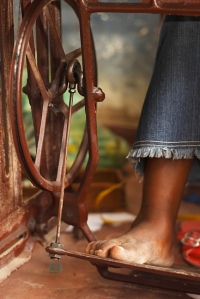








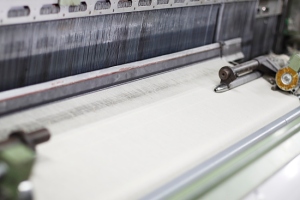




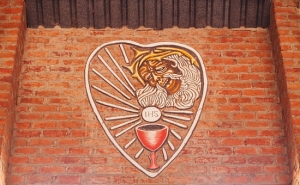


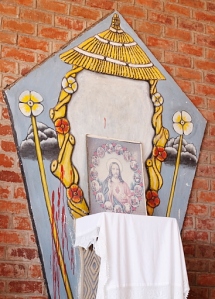
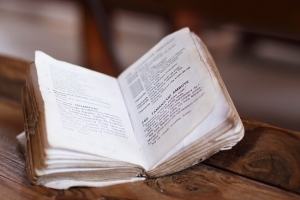

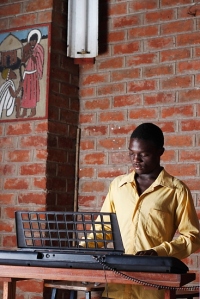
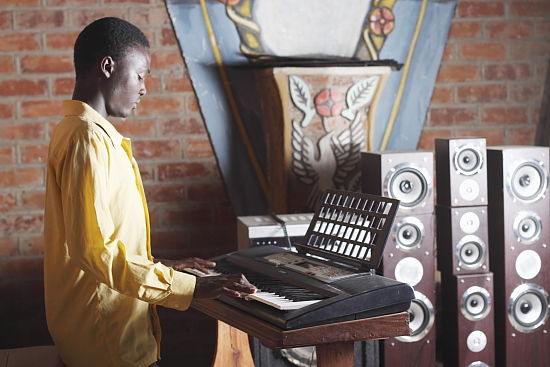
2 comments